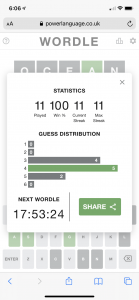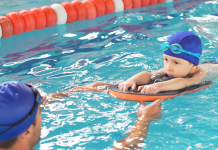If you’re over the age of 30 and therefore still use Facebook as your primary social media platform, your Newsfeed has been lit up with an obscure pattern of green and yellow boxes neatly arranged in rows with a seemingly random numerical sequence at the top. Below, comments such as “Wow!” “Impressive!” or “Same here!” pour in. You likely have discovered by now that these posts are actually humble brags about the daily Wordle puzzle.
 Created by Josh Wardle, a software engineer in Brooklyn, for his wife who loves word games and was bored during the pandemic, the game asks players to guess a five-letter mystery word in six tries or less. Green, yellow, and gray squares reveal correct and incorrect letters and letter placement.
Created by Josh Wardle, a software engineer in Brooklyn, for his wife who loves word games and was bored during the pandemic, the game asks players to guess a five-letter mystery word in six tries or less. Green, yellow, and gray squares reveal correct and incorrect letters and letter placement.
Wordle has created a phenomenon across the Internet. (Honest to goodness, while writing this, I received not one but two text messages about Wordle.) Though many are intrigued by the game, as a reading teacher and linguistic enthusiast, I found myself pondering how the challenge is supported by the science of reading. How are our brains able to so quickly deduct the seemingly endless possibilities of five letter words and guess the correct word in less than six tries? The answer lies in your occipital lobe.
The English language consists of 250 letter combinations, known as graphemes, which spell the approximately 44 sounds, or phonemes, used. As English readers and writers, we have internalized these combinations and can recognize a word as English or not-English based on whether they fit into the pattern of English spellings or not. Suppose that I asked you to label the following words according to whether they could be English or not, could you do it?
Noogle.
Kiitos.
Yksi.
Teaning.
Nakurmiik.
Ulaakut.
Of course you could. The double i (“ii”) is not an English grapheme. Neither is “Yk”. And English words don’t typically end in “k” as in Nakurmiik, but in “ck”. While “noogle” and “teaning” are not true English words, we recognize the letter combinations as English graphemes. In other words, they could be English words. (By the way, nakurmiik and ulaakut are “thank you” and “good morning” in Inuktitut, a language spoken by the Inuit. “Kiitos” and “yksi” mean “thank you” and “one” in Finnish.)
This knowledge of spelling patterns is also known as the orthographic processor, and is stored in the occipital lobe of your brain. When you are playing Wordle, your orthographic processor is hard at work. For example, in today’s puzzle, I reached this spot:
Your knowledge of English graphemes helps you deduce that KN, UN, and IN are the only remaining possibilities for the beginning of the word. Unable to think of a five-letter word with the prefixes un- or in-, KN is your best option. It’s not long before you think of that word you associate with the JFK assassination (grassy KNOLL, anyone?).
 Your orthographic processor also explains why you sometimes guess words that are not in the database. Since you have internalized English spelling patterns, WINOR is a perfectly reasonable word to try when you’re stuck on W I N _ _. Winor is not an English word, but its spelling patterns are compatible and recognizable as English graphemes, much like noodle and teaning from above.
Your orthographic processor also explains why you sometimes guess words that are not in the database. Since you have internalized English spelling patterns, WINOR is a perfectly reasonable word to try when you’re stuck on W I N _ _. Winor is not an English word, but its spelling patterns are compatible and recognizable as English graphemes, much like noodle and teaning from above.
Finally, the science of reading will help you solve the quandary of the ideal starting word. Some English graphemes are more commonly used than others. Most kindergarten phonics programs begin with the letters M, C, A, O, D, and T for good reason. Rarely do we choose to teach our students the grapheme OUGH first. You’ll notice in my above example that I began with the word OCEAN. By using this word, I eliminated three vowels and two of our most common consonants, C and N. By that logic, another starting word to consider might be AUDIO with four vowels and the oft-used D.
So, while you may think your Wordle success stems from your outstanding vocabulary, it’s much more likely that your orthographic processor is to thank.

















